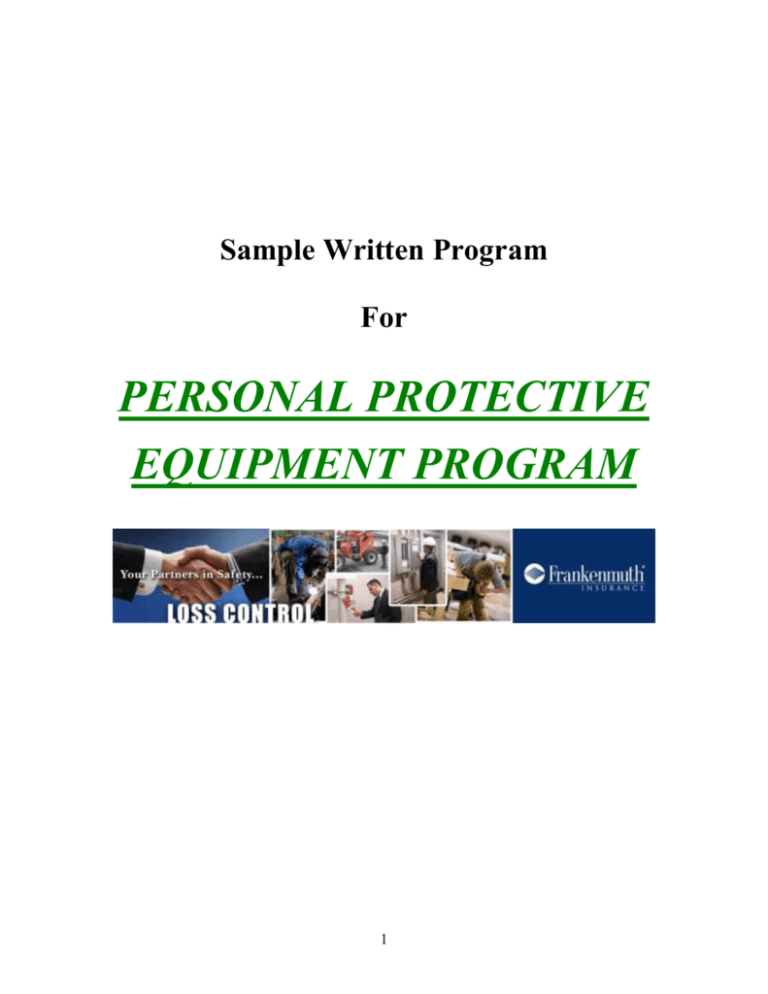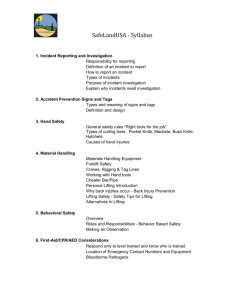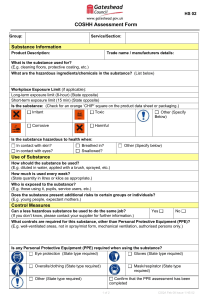PERSONAL PROTECTIVE EQUIPMENT PROGRAM
advertisement

Sample Written Program For PERSONAL PROTECTIVE EQUIPMENT PROGRAM 1 TABLE OF CONTENTS Development …………………………………………......………………………3 Hazard Assessment……………………………………....…………………...…..3 Choosing Personal Protective Equipment………….………………....…..............4 Training………………………………………… .…………………...…..............4 Conclusion………………………………………………………………..............4 Instruction for Hazard Analysis……………………………………………...…...5 Program Example …………….……………………………………………...…...6 Hazard Analysis Worksheet………………………………………………… 7 & 8 2 Personal Protective Equipment The Occupational Safety and Health Administration (OSHA) requires employers to protect their employees from workplace hazards through the use of engineering or work practice controls. If the machine or work environment can be physically changed to prevent employee exposure to the potential hazard, then the hazard can be eliminated with an engineering control. If employees can be removed from exposure to the potential hazard by changing the way they do their jobs, then the hazard can be eliminated with a work practice control. When these controls are not feasible or do not provide sufficient protection, the use of personal protective equipment (PPE) is required. Employers are required to assess the workplace to determine if hazards are present, or are likely to be present, that would require the use of PPE. If PPE is to be used to reduce the exposure of employees to hazards, a PPE program should be developed and maintained. The components the program should contain are: Identification and evaluation of hazards in the workplace Procedures on personal protective equipment selection Procedures on personal protective equipment maintenance Procedures for the evaluation of the effectiveness of the personal protective equipment Procedures to train employees on the effective use of PPE. Personal protective equipment should not be used as a substitute for engineering, work practice, and/or administrative controls. PPE should be used in conjunction with these controls to provide for employee safety and health in the work place. Personal protective equipment includes all clothing and other work accessories designed to create a barrier against workplace hazards. Using personal protective equipment requires hazard awareness and training on the part of the user. Employees must be aware that the equipment does not eliminate the hazard. If the equipment fails, exposure will occur. To reduce the possibility of failure, equipment must be properly fitted and maintained in a clean and serviceable condition. Selection of the proper personal protective equipment for a job is important. Employers and employees must understand the equipment’s purpose and its limitations. The 3 equipment must not be altered or removed even though an employee may find it uncomfortable. (Sometimes equipment may be uncomfortable simply because it does not fit properly.) Hazard Assessment Employers are required to assess the workplace to determine if hazards that require the use of personal protective equipment are present or are likely to be present. If hazards or the likelihood of hazards are found, employers must select and have affected employees use properly fitted personal protective equipment suitable for protection from these hazards. Note: Respirators, hearing protection and rubber insulating equipment are considered PPE. However, because OSHA has specific requirements for them, they are not discussed here. During the hazard assessment survey, managers and supervisors should identify any hazards that require the use of head, eye, hearing, face, hand, and/or foot protection. Potential hazards to look for are: Impact – chipping, grinding, machining, masonry work, woodworking, sawing, drilling, chiseling, powered fastening, riveting, and sanding Penetration – sharp objects that could go through the skin: nails, knives, saws Compression – construction, plumbing, smithing, building maintenance, trenching, utility work, moving equipment operations (powered industrial trucks, lawn equipment, etc.) Hazardous chemical exposures – pouring, mixing, painting, cleaning, siphoning, dip tank operations, dental and health care services Heat – welding, pouring molten metal, smithing, baking, cooking, and drying Light radiation – welding: electric arc, gas, cutting, torch brazing, soldering, and glare Electrical hazards – building and tool maintenance, utility work, construction, wiring, computer and arc or resistance welding Harmful dusts – sawing, drilling, sanding, abrasive blasting, and grinding 4 Employers must certify in writing that a workplace hazard assessment has been performed and keep it on file. Choosing Personal Protective Equipment Select the protective equipment that ensures a level of protection greater than the minimum required to protect employees from the hazards. Careful consideration must be given to comfort and fit. Personal protective equipment must fit properly to be effective. For the worker’s comfort and protection, proper fit is critical. If the protective gear does not fit, it may not adequately protect the worker. When protective gear is uncomfortable it is hard to concentrate on the job and it may tempt workers to remove it. Continued wearing of PPE is more likely if it fits the worker comfortably. Personal protective equipment is generally available in many sizes. Care should be taken to ensure that the correct size is selected. Defective or damaged personal protective equipment shall not be used. Training Before doing work requiring the use of personal protective equipment, employees must be trained to know: When personal protective equipment is necessary What type is necessary based on job function How it is to be worn – don, adjust, doff, wear The limitations of the personal protective equipment Proper care, maintenance, useful life, and disposal of PPE Each affected employee must demonstrate an understanding of the required training, and the ability to use PPE properly, before being allowed to perform work requiring the use of PPE. Employers must certify in writing that training has been carried out and that employees understand and can demonstrate the proper use of the personal protective equipment. If the employee does not have the required skill and understanding, 5 retraining is required. Each written certification shall contain the name of each employee trained, the dates of training, and identify the subject certified. Conclusion To have an effective personal protective equipment program, one person (manager, supervisor, safety) must be responsible for its coordination. First-line supervisors must be convinced of the hazards and must be held accountable for their employees’ use of PPE. It is necessary for new employees to receive training during orientation. Employees should be motivated to continue to use protective gear through an on-going safety program. Personal protective equipment can be effective only if the equipment is selected based on its intended use, employees are trained in its use, and the equipment is properly tested, maintained, and worn. 6 PERSONAL PROTECTIVE EQUIPMENT HAZARD ANALYSIS In order to meet OSHA requirements (29 CFR 1910.132), and in order to maintain a safe working environment, it will be necessary for all supervisors and managers to analyze the potential job hazards within their area. Please complete and return the analysis. Instructions for this analysis follow. Thank you for your help in taking an active part in safety. Instructions 1. Identify the job titles for all persons within your department. 2. Make copies of the Personal Protective Equipment Hazard Analysis form so that each job is represented on a separate form. 3. Enter the name of your department. 4. Enter the job title to be analyzed. 5. Enter the location or area of the facility that the job holder performs the activities or tasks. Examples of this might be “office,” “maintenance shop,” “warehouse,” etc. 6. Enter your name after “Analysis done by”. 7. Enter the date of the analysis. 8. List the activities or tasks that the job holder is required to perform. 9. Use the Hazard Key to identify ALL potential hazards associated with each task. Enter the hazard numbers in the area corresponding to the activity or task. Use a separate line for each hazard. 10. Use the Body Part Key to identify the part of the body that would be exposed to each hazard. If more than one body part has hazard exposure, list all parts. Enter the body part letters in the area corresponding to the hazard. 11. Use the PPE Required key to identify the personal protective equipment required for each hazard listed. 7 Personal Protective Equipment Program For (Your Company Name) (Reference: 29 CFR 1910.132) Your Company Name will assess our workplace to determine if hazards are present or likely to be present which requires the use of Personal Protective Equipment (PPE). If hazards are present or likely to be present, the Your Company Name shall: • Select the type of PPE that will protect the employee. • Require the employee to use the PPE. • Communicate selection decisions to each affected employee. (Reference: 29 CFR 1910.132 (d)(1)(i - iii)) The Your Company Name shall verify the hazard assessment has been performed through a written certification. The certification shall: • Identify the workplace where assessment was performed. • Name the person certifying that the assessment was performed. • Give the date(s) that the hazard assessment was performed. • Be identifiable as a document of certification of hazard assessment. (Reference: 29 CFR 1910.132 (d)(2)) Assure that defective or damaged PPE not be used. (Reference: 29 CFR 1910.132(e)) The Your Company Name will provide training to each employee who is required by this section to use PPE. Each employee shall be trained to know at least the following: 8 • When PPE is necessary; • What PPE is necessary; • How to put on, take off, adjust, and wear PPE; • Limitations of PPE; and • Proper care, maintenance, useful life, and disposal of the PPE. (Reference: 29 CFR 1910.132 (f)(1)(i-v)) Before being allowed to perform work that requires the use of PPE, each employee shall: • Demonstrate an understanding of training provided; • Demonstrate ability to properly use PPE. When the Your Company Name has reason to believe that an employee does not understand the training or possess the skill required to wear the PPE the employer shall retrain the employee. Other circumstances where retraining is required include, but is not limited to: • Changes in the workplace that render previous training obsolete. • Changes in PPE that render previous training obsolete. • Employee does not retain understanding or skill to use PPE. The Your Company Name shall verify that each affected employee receives and understands the required training. The verification shall: • Be a written certification. • Show the name of the employee trained. • Show the date(s) of training. • Identify the subject of certification. The information and suggestions contained in this material have been developed from sources believed to be reliable. However, Frankenmuth accepts no legal responsibility for the correctness or completeness of this material, or its application to specific factual situations. 9 Hazard Analysis Worksheet 10 11




